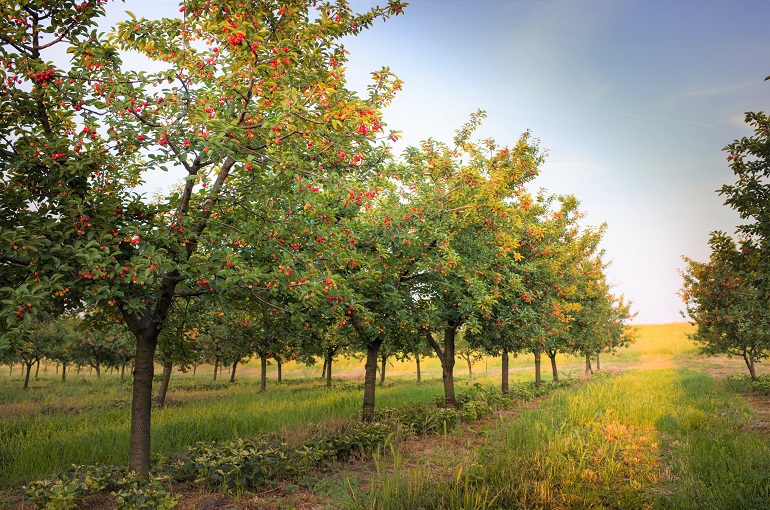Cherry Tree Pests and Diseases

This post is also available in:
This post is also available in:
![]() Español (Spanish)
Español (Spanish) ![]() Français (French)
Français (French) ![]() Deutsch (German)
Deutsch (German) ![]() Nederlands (Dutch)
Nederlands (Dutch) ![]() हिन्दी (Hindi)
हिन्दी (Hindi) ![]() Türkçe (Turkish)
Türkçe (Turkish) ![]() 简体中文 (Chinese (Simplified))
简体中文 (Chinese (Simplified)) ![]() Ελληνικά (Greek)
Ελληνικά (Greek) ![]() Português (Portuguese (Brazil))
Português (Portuguese (Brazil))
Unfortunately, cherry trees suffer from various fungal and bacterial diseases and pests. Growers should plan an environmentally friendly approach in order to tackle them. Seeking advice from local professionals is highly recommended. Some of the most common and economically important pests and diseases of cherry trees are mentioned below.
Pests
- Western and European Cherry Fruit Fly (Rhagoletis cingulata and R. cerasi): They are considered 2 of the cherry tree’s most destructive and common pests. The adults can easily be distinguished by the characteristic banding pattern on the wings. The flies lay their eggs inside the fruit when it starts becoming reddish. The hatched white maggots feed on the fruit flesh, causing the fruits to soften and rot. No damage from the pest on the fruits is commercially acceptable, and growers must take all possible preventive measures to avoid any yield loss.
- Cherry Blackfly or Black Cherry Aphids (Myzus cerasi): It is a black aphid that feeds on the leaves (sap) and can cause significant damage to cherry trees. The infested trees usually have curled and wilted leaves. Additionally, the formation and development of buds are reduced, and the new vegetation is stunted and covered by honeydew that favors secondary infections by Fumago vagans fungus.
- Birds and Rodents (e.g., Pocket Gophers): Birds can be a major problem, especially in sweet cherry orchards, since they feed on the fruits. On the other hand, pocket gophers or moles can injure or even kill cherry trees by feeding on the crown and roots of the tree.
Other pests of interest for cherry trees are the: leaf miners, Spider Mites (red mites), Pacific Flatheaded Borer, Shothole Borer (Scolytus rugulosus), Spotted Wing Drosophila, Nematodes, Cherry Thrips, and Cherry Slugs.
Diseases
- Brown Rot or Blossom blight: It is a highly damaging fungal disease caused by the pathogen Monilinia fructicola that can lead to significant yield losses. The disease becomes a major problem for cherry farmers during wet seasons when the temperature exceeds 10 °C (during flowering) and can affect flower buds, flowers, and fruits. These plant parts, when infected, are covered with gray-brown mold, wither, rot, and drop. As the disease spreads, spores grow on the drupes. More specifically, cherry fruits appear to have brown spots. If the grower doesn’t take preventive or control measures on time, the disease will eventually consume the whole fruit.
- Bacterial canker: It is one of the most severe diseases in cherry trees caused by the Pseudomonas syringae bacteria. The pathogen can enter the plant from wounds-injuries caused by the tree bark pruning or extreme weather (e.g., hailstorm or frost) and forms cankers (of dark orange to black color). In young trees, the disease may lead to the destruction (wilting, the branches dieback) of up to 75-80% of the tree. The spread and outbreak of the disease are favored by cool wet-rainy weather during mid-fall and early spring.
- Crown gall: It is an important bacterial disease caused by the pathogen Agrobacterium tumefaciens, which usually enters the cherry tree through wounds. In the infected plant roots or trunk, we can observe the creation of various abnormal galls (tumors), which can finally block the water and nutrients which are supposed to be transferred from the roots to the tree canopy. Infected trees develop leaves of smaller size and become weak and unproductive. The disease is more destructive in young trees (new plantations or plant nurseries).
Pests and Diseases Control measures
The best way to control pests and diseases is always prevention rather than intervention. Cherry tree growers shall take into consideration the following measures.
- Avoiding excessive fertilizer application.
- Use of certified seeds (if we start the trees from seeds).
- Use of varieties resistant to local diseases.
- Protective nets can be used to cover the trees in order to protect the fruits from birds and hail.
- Keeping the field free from weeds may reduce the risk of disease outbreaks.
- Experienced growers suggest spraying the trees with sulfur (micronized or wettable sulfur) during flowering to control brown rot. This usually requires 4 applications: 1) when the flower buds are pink, 2) when they start to open, 3) when the petals begin to fall, 4) and one final application, normally 2 weeks after the last one.
To control bacterial canker, some farmers spray with copper and horticultural oil during the bud stage 3. The application should be repeated in autumn when leaves start falling.
- Avoid injuring the trees during pruning (avoid pruning with rainy-wet-cloudy weather).
- Growers should seek advice from local professionals.
References
- https://anrcatalog.ucanr.edu/pdf/2951e.pdf
- https://www2.ipm.ucanr.edu/agriculture/cherry/Crown-gall/
- https://extension.usu.edu/pests/research/backyard-cherry-pests
- https://u.osu.edu/cfaescapstone/tree-fruits/cherries/pests/
Cherries: Info, Facts, Nutritional Value & Health Benefits
Plant Information of cherries
10 Interesting Things About Cherries You Probably Didn’t Know
Growing Cherry Trees for Profit
Soil requirements, preparation, and planting of cherry trees
Cherry Tree Water Requirements
Cherry Tree Propagation and Pollination
Cherry Tree Training, Pruning, and Fruit Thinning
Cherry Tree Fertilization
Cherry Tree Pests and Diseases
Cherries Harvesting and Yield per Hectare – Do you pick cherries with the stem on or off?








































































